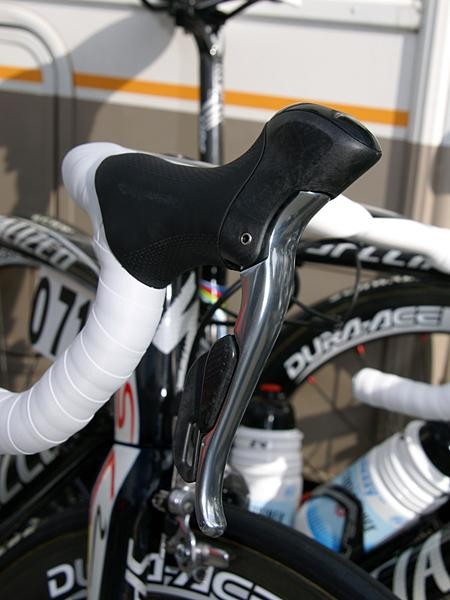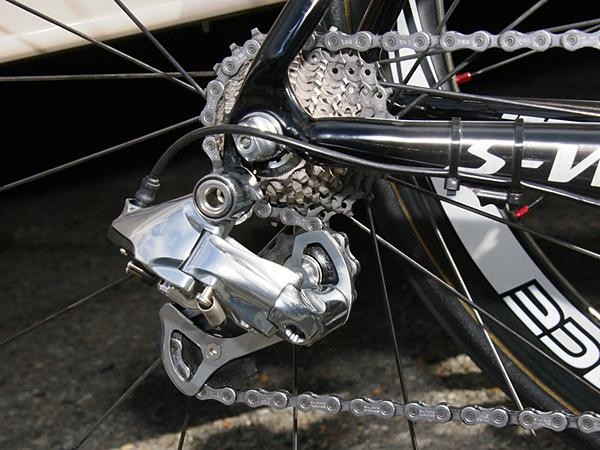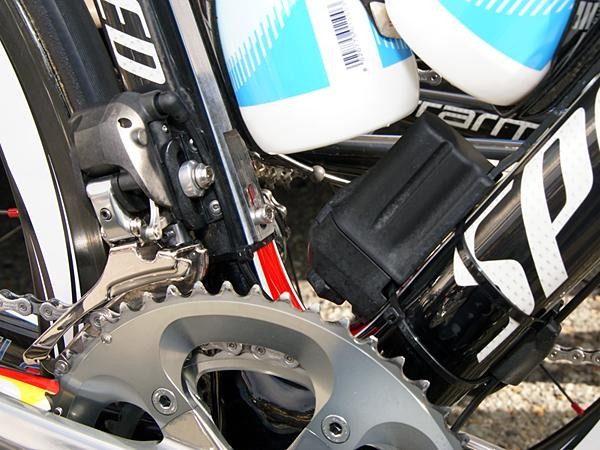What's to come for 2009
The behind-the-curtains development of Shimano's next generation of Dura-Ace componentry has quickly...






Tech feature: 2009 Dura-Ace 7900 rumors milled, March 26, 2008
The behind-the-curtains development of Shimano's next generation of Dura-Ace componentry has quickly evolved into yet another example of one of the worst-kept secrets in the industry. Much to the chagrin of Shimano (and unfortunately, retailers as well), seemingly accurate information has already made the rounds and it's safe to say at this point that the beans have been spilled.
However, in spite of the wealth of information circulating about, we should stress that Shimano still will not officially confirm or deny anything regarding new Dura-Ace componentry but the facts listed here are correct to our knowledge. According to Shimano press officer Devin Walton, "We've always got products and prototypes that we're working on, developing, and preparing for sale once the concepts and products have been proven. I think the prototypes that have been 'spied' at various pro events are a prime example of that development process in motion."
Official or not, it's fairly common knowledge that Shimano will eventually unveil not one, but two new Dura-Ace groups presumably for 2009. We're unfortunately still on the hunt for good close-up images to post, but the information is compelling enough on its own for now.
Dura-Ace 7900 mechanical - faster and lighter, but broader appeal, too
Dura-Ace 7900 looks to be a significant step forwards in terms of performance but Shimano has also taken steps to increase the group's usability for more casual riders. Rumours suggest the mechanical version will reportedly be over 180g lighter than Dura-Ace 7800 although we'll see how accurate that figure is once final production is underway. Along with that proposed weight loss comes improved drivetrain efficiency, faster and more robust shift performance, and a wider range of gear options than before.
More cable, please
Get The Leadout Newsletter
The latest race content, interviews, features, reviews and expert buying guides, direct to your inbox!
Shift quality looks to be of paramount importance as usual and Shimano has made the bold decision to increase the cable pull on the new 7900 group. Much like SRAM and Campagnolo, this means that the new drivetrain should be far more tolerant of housing contamination, slight maladjustments and hanger dimension variances than before but this also means that the new shifters and rear derailleur won't be compatible with any other 10-speed Shimano components for now.
Even with the increased cable pull, shift lever throw is reportedly 20 percent shorter than before. Currently there's no word on whether or not Shimano will integrate the Multi Release or Instant Release features first seen on XTR M970 for even faster upshifts although we'd be surprised if neither showed up.
The new STI Dual Control levers themselves will finally ditch the old-school hood shape in favour of a flatter and more hand-friendly top surface. Carbon brake lever blades and titanium hardware will drop some weight while adjustable lever reach will better accommodate smaller hands and a wider assortment of bar bends. As we reported earlier, derailleur housing will finally be concealed beneath the bar tape for a cleaner appearance.
Optional equipment for the new levers includes an updated Flight Deck integrated wireless computer. In addition to the usual speed and distance functions, the new Flight Deck will add an on-board altimeter, inclinometer and heart rate monitor. For the first time, ride data will also be downloadable to a PC for later analysis.
The rear derailleur lightens up with a carbon cage assembly while tooth capacity on the standard cage has been increased to 28T (we assume this means the mid-length GS cage has been deleted). The front derailleur has been retuned for even lighter shift effort and the cage profile has been designed such there is supposedly no trimming required whatsoever for any gear combinations. While this last feature sounds decidedly untraditional, that's also what we all said years ago with mountain bike drivetrains. If anyone can figure this out (and force it upon the masses), it's Shimano.
Drivetrain: stiffer and smoother
As many expected, the new crankset will still be made of hollow-forged aluminium but stiffness is reportedly increased 20 percent - a remarkable figure considering the stiffness of the existing version. A new outer chainring design bumps rigidity up 20 percent as well although it's unclear whether or not those two increases are additive or inclusive. For the first time in Dura-Ace history, Shimano will finally offer a compact version. It's unclear at this point whether or not a triple-chainring version will continue to be on tap as well (we suspect not, but who knows).
Hallelujah! The new Dura-Ace 7900 chain will finally use a quick connect link for easier maintenance as well as hollow pins and milled-out side plates for lighter weight. The new chain will also be asymmetrical for reduced chain suck and increased precision will supposedly make for a 0.6 percent increase in efficiency. We're about as excited about the 0.6 percent as you are (ahem) but that improved efficiency does suggest a quieter running chain.
Cassette weights have supposedly dropped a bit courtesy of a new aluminium carrier. More importantly, cog ratio options have vastly broadened to include combinations that are more usable to casual riders such as a wall-climbing 11-28T.
We still don't have confirmation on the future of the carbon fibre crankset shown last year but given its dubious advantage over the alloy 7900 version we'd be surprised to see it carry on another season. We have heard, however, that a BB30-compatible alloy version may be on the way though that's strictly an unsubstantiated rumour at this point. We'll have to wait and see on this one.
Brakes
Refined dual-pivot architecture is presumed to improve power and modulation over current offerings and cable routing has been cleaned up a bit for reduced friction. A new pad compound is reported to decrease stopping distances substantially in both wet and dry conditions. Titanium hardware sheds a few grams.
Dura-Ace Di2 - shifting at the speed of light
Many will still view an electronic group as being more complicated just for the sake of being, but the simple fact is that the technology potentially offers performance advantages that are practically unattainable with mechanical systems. Based on our experience with earlier prototypes, shift button throws are remarkably short and derailleur movements are much faster than spring-loaded versions.
We won't go into too many details on the group's appearance since we've shown it to you already, but contrary to speculation, the complete Dura-Ace Di2 group will not only shift faster than the current Dura-Ace group but our information suggests that it's also over 100g lighter, too, even with the required battery pack. Again, we'll see how close to reality those figures are come production. Regardless, some of the weight savings comes from the use of alternative materials such as on the mechanical version but we suspect the bulk of the loss comes from the omission of mechanical hardware.
Neat features include optional remote shift buttons for time trial and triathlon setups, a 'crash position' that helps shield the rear derailleur from damage during a fall, and an auto-trimming front derailleur. Regarding the latter, though, we're not sure why that would be necessary if Shimano is touting a 'trim-free' front derailleur on the mechanical version.
As for presumed reliability, we've all heard the unfortunate jokes comparing Shimano's new electronic group to Mavic's old Mektronic and Zap groups so we'll spare you here. Regular readers will recognize, though, that we've spotted these groups in the field for several years now and are rather confident that Shimano wouldn't dream of releasing this sort of technology to the public without thoroughly working out the bugs first. Reliability is also likely to be Shimano's primary reason for using a wired setup instead of a wireless one.
But why bother with electronic at all, you ask? We posed the question to Walton a while back regarding electronic groups in general and it isn't difficult to transfer his response to a performance-oriented system.
"The idea of operating a drivetrain electronically and using electrical actuation is one that Shimano has been engaged in for many years," he said. "Take for example our Nexus Auto-D internal four-speed system. The idea was to create a drivetrain that had the least amount of potential issues necessitating adjustment and versatile, yet simple operation. Friction and cable contamination are removed by using electrical signals; precision is ensured by precise servo motor movement; adjustment and accuracy are monitored with each shift; the user interface can be operated via a simple push of a button or using an automatic mode."
An automatic mode? Um, ok. Battery life is expected to be in the range of months for typical users although there's no word yet on what happens if it dies out on the road.
"It will make everyone else's road groups look like toys"
That was the comment we heard from one industry insider (who doesn't work at Shimano) and it'll be interesting to see if that holds true. We'll obviously reserve judgment until we have access to a proper test session on production gear but one thing is certain: the market is heating up yet again and we all stand to gain.